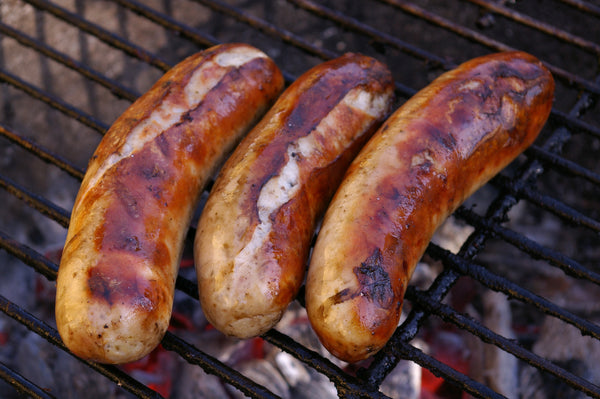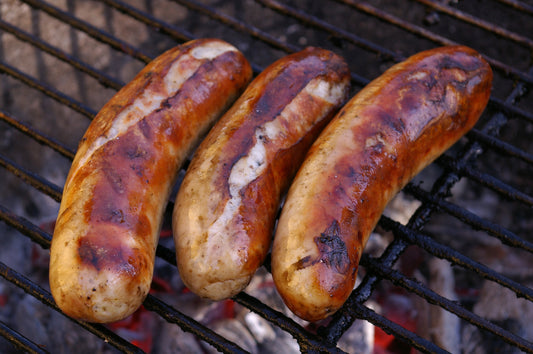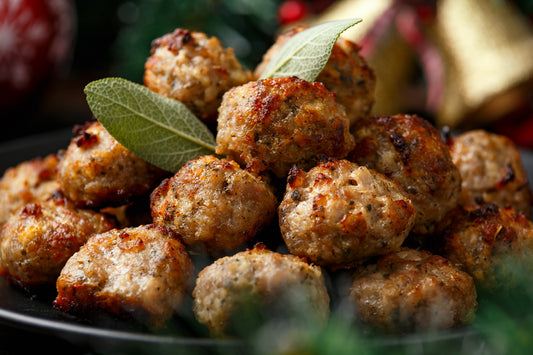I'm sure you've heard the horror stories, right? There's eyeballs, and feet, and all-sorts in sausage, you know?.. Absolutely WRONG. Let's clear up this misinformation.
What is Sausage?
First of all, lets define what exactly a sausage is, for anyone who's unaware... A sausage is, according to Google, "an item of food in the form of a cylindrical length of minced pork or other meat encased in a skin, typically sold raw to be grilled or fried before eating."
What is sausage made of?
Right, lets get into the meat of the issue. Pun most certainly intended. Anyway, most sausage is made up of minced/ground meat (usually pork, but you can make it with any meat), a binder (usually rusk, sometimes rice flour in gluten free versions), water, and seasonings. Now, some commercial sausages may also contain fat, emulsified pork rinds, or even chicken skin, but that's really about as gruesome as it gets these days. If you don't believe me, you can always check the ingredients on any pre-packed sausages next time you're near some, as any offal, or fat, is required to be listed in the ingredients separately from any meat. Even any blood used, in blood sausage, or black pudding for example, will be listed separately in the ingredients.
What animal parts are in sausage?
Most butchers sausages are made up from meat trimmings. For example, any trim taken from chops, or steaks, or parts removed when producing roasting joints, will be used in the sausage they produce. Other than that, parts of the animal like shoulder, or belly, will be used as these cuts carry a bit more fat, which is necessary in sausage to produce the right consistency in the final product.
All butchers, and sausage makers, have their preferred mix of meat, in terms of which cuts they use, and how lean they are. You really don't want to use meat that is too lean, otherwise the final sausage will be gritty. If you use too much fat, then your final sausage will have a paste like consistency. Each producer will really have their own method, but that being said, a good rule of thumb is to use meat with around an 80 percent visual lean. In other words, you want 80% lean to 20% fat ratio in order to have enough fat in the mix to produce a nice smooth sausage. With this in mind, most sausage will be made with shoulder, and/or a combination of belly, and leg.
A good quality sausage will not contain any 'less desirable' parts of the animal, or any offal. We certainly do not use any when making our sausage, and most butchers worth their salt don't either. The main reason for this is, it just doesn't create a quality sausage with the right consistency as a final product. Furthermore, for your peace of mind, any offal used in the making of sausage is required by law (in the UK) to be stated on the ingredients list, along with the percentage of the final product. So, you're certainly not eating anything you're unaware of.
Right, it's worth stating again, unless it is listed on the ingredients of the product that there is offal used in it's making, there is absolutely no head meat, no lips, no ears, or God knows whatever else someone once told you is in there.
What is a binder?
A binder is something used in the recipe to help bring the meat, and other ingredients together. Without a binder the sausage can easily split, leaving in with a rough gritty texture, which would be rather unpleasant to eat. The most common binder used in sausage is rusk, although other binders, such as rice flour, are often used in gluten free versions.
What is rusk?
Rusk is mainly made up of wheat flour, which is fortified with calcium carbonate, iron, niacin, and thiamin. It also contains salt, and ammonium bicarbonate, which is used to aid the production process.
What is in sausage seasoning?
There are many types of sausage seasonings, which can be as basic as just salt and pepper, or super complex with a variety of herbs and spices. The most common seasonings for sausage would be salt, white pepper, black pepper, sage, marjoram, nutmeg, and cloves to name a few. It is also common for producers to add fresh ingredients, such as leeks, or chilli's for flavourings. Sometimes producers may even add other meats, such as black pudding, which is popular in the UK.
Meat content of sausage
A good breakfast sausage should have around a 55% pork content or more. As sausage is a low cost item, that's really the traditional way it would be made to keep costs down. This is ideal as is produces a nice texture that's not too heavy or gritty. This style of sausage would usually be filled into collagen casings, as these help produce a uniformed size and shape, which is perfect for wholesale production, and for caterers working to costing etc.
A premium sausage should be around 75% pork or more. This produces a nice, firm and meaty sausage, which is perfect for bangers and mash, a posh breakfast, or awesome hotdogs on the bbq. This style of sausage would usually be filled in to natural skins and hand linked into portions. Just like the sausage you see hanging in butchers shops etc. These are much thicker, and thus take much longer to cook.









1 comment
I feel better about the sausage now. I’m hearing mealworms are in some meat/food. I can’t seem to find a direct answer from other sources online. Can you tell me which ones? 🤢